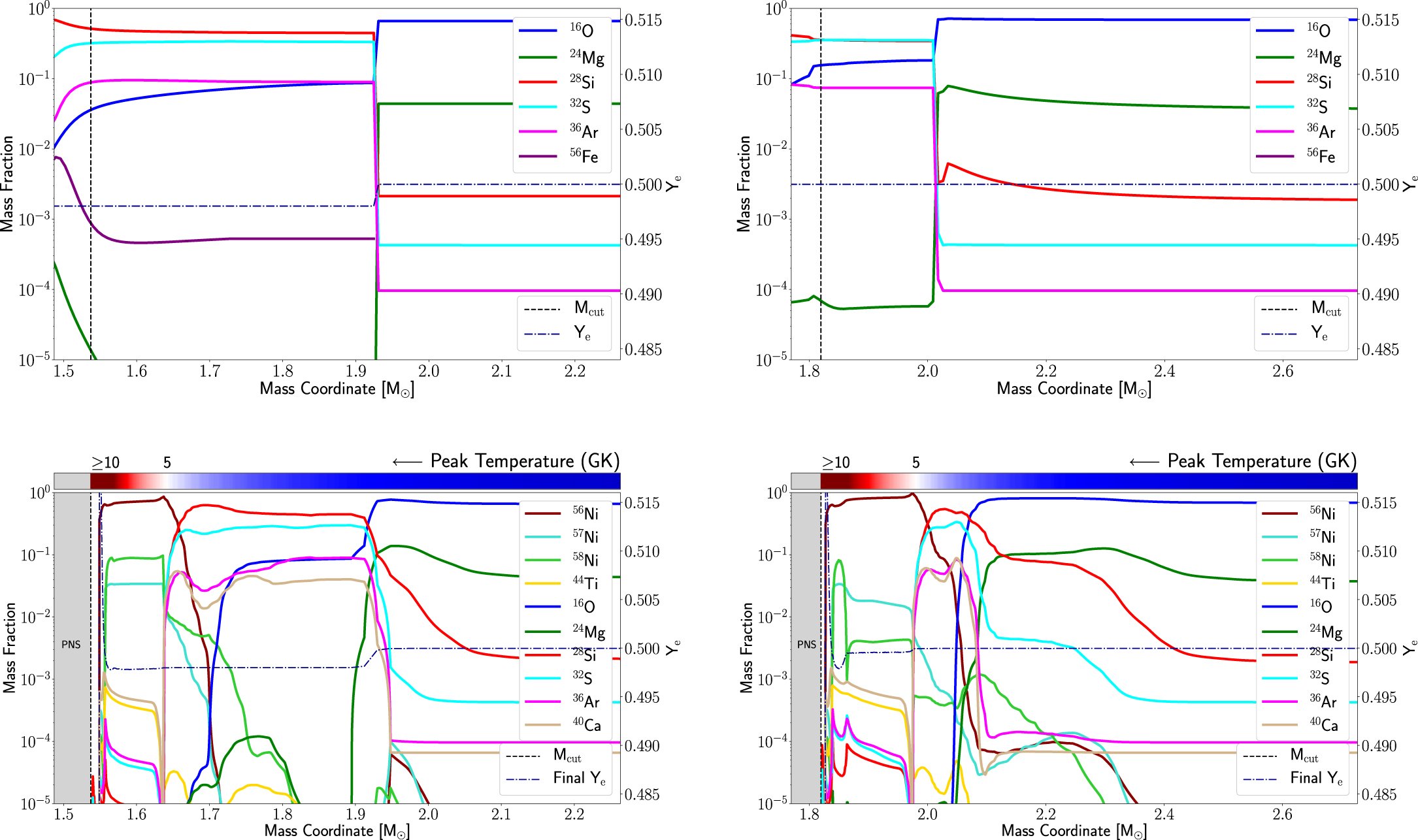First Author Publications
Nucleosynthesis in Outflows from Black Hole-Neutron Star Merger Disks With Full GRνRMHD
Along with binary neutron star mergers, the in-spiral and merger of a black hole and a neutron star is a predicted site of r-process nucleosynthesis and associated kilonovae. For the right mass ratio, very large amounts of neutron rich material may become unbound from the post-merger accretion disk. We simulate a suite of four post-merger disks with full-transport general relativistic neutrino radiation magnetohydrodynamics. We find that the outflows from these disks are very close to the threshold conditions for robust r-process nucleosynthesis. For these conditions, the detailed properties of the outflow determine whether a full r-process can or cannot occur, implying that a wide range of observable phenomena are possible. We show that on average the disk outflow lanthanide fraction is suppressed relative to the solar isotopic pattern. In combination with the dynamical ejecta, these outflows imply a kilonova with both blue and red components.
r-process nucleosynthesis and kilonovae from hypermassive neutron star post-merger remnants
We investigate r-process nucleosynthesis and kilonova emission resulting from binary neutron star (BNS) mergers based on a three-dimensional (3D) general-relativistic magnetohydrodynamic (GRMHD) simulation of a hypermassive neutron star (HMNS) remnant. The simulation includes a microphysical finite-temperature equation of state (EOS) and neutrino emission and absorption effects via a leakage scheme. We track the thermodynamic properties of the ejecta using Lagrangian tracer particles and determine its composition using the nuclear reaction network SkyNet. We investigate the impact of neutrinos on the nucleosynthetic yields by varying the neutrino luminosities during post-processing. The ejecta show a broad distribution with respect to their electron fraction Ye, peaking between ~0.25-0.4 depending on the neutrino luminosity employed. We find that the resulting r-process abundance patterns differ from solar, with no significant production of material beyond the second r-process peak when using luminosities recorded by the tracer particles. We also map the HMNS outflows to the radiation hydrodynamics code SNEC and predict the evolution of the bolometric luminosity as well as broadband light curves of the kilonova. The bolometric light curve peaks on the timescale of a day and the brightest emission is seen in the infrared bands. This is the first direct calculation of the r-process yields and kilonova signal expected from HMNS winds based on 3D GRMHD simulations. For longer-lived remnants, these winds may be the dominant ejecta component producing the kilonova emission.
Core-collapse Supernovae: From Neutrino-driven 1D Explosions to Light Curves and Spectra
We present bolometric and broadband light curves and spectra for a suite of core-collapse supernova models exploded self-consistently in spherical symmetry within the PUSH framework. We analyze broad trends in these light curves and categorize them based on morphology. We find that these morphological categories relate simply to the progenitor radius and mass of the hydrogen envelope. We present a proof-of-concept sensitive-variable analysis, indicating that an important determining factor in the properties of a light curve within a given category is 56Ni mass. We follow spectra from the photospheric to the nebular phase. These spectra show characteristic iron-line blanketing at short wavelengths and Doppler-shifted Fe II and Ti II absorption lines. To enable this analysis, we develop a first-of-its-kind pipeline from a massive progenitor model, through a self-consistent explosion in spherical symmetry, to electromagnetic counterparts. This opens the door to more detailed analyses of the collective properties of these observables. We provide a machine-readable database of our light curves and spectra online at go.ncsu.edu/astrodata.
PUSHing core-collapse supernovae to explosions in spherical symmetry IV: Explodability, remnant properties and nucleosynthesis yields of low metallicity stars
IIn this fourth paper of the series, we use the parametrized, spherically symmetric explosion method PUSH to perform a systematic study of two sets of non-rotating stellar progenitor models. Our study includes pre-explosion models with metallicities Z=0 and Z=Z⊙×10−4 and covers a progenitor mass range from 11 up to 75 M⊙. We present and discuss the explosion properties of all models and predict remnant (neutron star or black hole) mass distributions within this approach. We also perform systematic nucleosynthesis studies and predict detailed isotopic yields as function of the progenitor mass and metallicity. We present a comparison of our nucleosynthesis results with observationally derived 56Ni ejecta from normal core-collapse supernovae and with iron-group abundances for metal-poor star HD~84937. Overall, our results for explosion energies, remnant mass distribution, 56Ni mass, and iron group yields are consistent with observations of normal CCSNe. We find that stellar progenitors at low and zero metallicity are more prone to BH formation than those at solar metallicity, which allows for the formation of BHs in the mass range observed by LIGO/VIRGO.
PUSHing Core-collapse Supernovae to Explosions in Spherical Symmetry. III. Nucleosynthesis Yields
In a previously presented proof-of-principle study, we established a parameterized spherically symmetric explosion method (PUSH) that can reproduce many features of core-collapse supernovae (CCSNe) for a wide range of pre-explosion models. The method is based on the neutrino-driven mechanism and follows collapse, bounce, and explosion. There are two crucial aspects of our model for nucleosynthesis predictions. First, the mass cut and explosion energy emerge simultaneously from the simulation (determining, for each stellar model, the amount of Fe-group ejecta). Second, the interactions between neutrinos and matter are included consistently (setting the electron fraction of the innermost ejecta). In the present paper, we use the successful explosion models from Ebinger et al. that include two sets of pre-explosion models at solar metallicity, with combined masses between 10.8 and 120 M⊙. We perform systematic nucleosynthesis studies and predict detailed isotopic yields. The resulting 56Ni ejecta are in overall agreement with observationally derived values from normal CCSNe. The Fe-group yields are also in agreement with derived abundances for metal-poor star HD 84937. We also present a comparison of our results with observational trends in alpha element to iron ratios.





